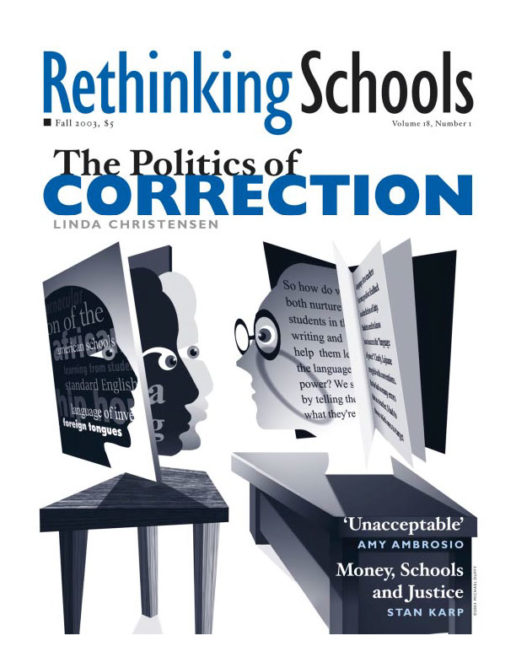Time to Renew Movements for Justice
A Rethinking Schools Editorial
Illustrator: Diana Craft

It’s hard to recall a time in our lives when students and educators returned to school under such difficult circumstances. Deep budget cuts. A testing craze. A school “reform” law that plays havoc with public education across the country. A fund-the-wealthy approach to tax reform. And a president who seems hell-bent on alienating most other nations and lining the pockets of his corporate buddies.
Many urban and rural school districts, in particular, are suffering from the cumulative effects of budgets cuts. Thousands of children no longer attend music, physical education, or art classes; even more students endure overcrowded classrooms and reduced support services; and teachers are experiencing the educational equivalent of industrial “speed-up.”
Those programs and schools fortunate enough to have survived the budget cuts are threatened by the growing testing epidemic. Nineteen U.S. states require students to pass exit exams to earn high school diplomas. President Bush’s under-funded No Child Left Behind act forces states to administer annual tests in six elementary and middle school grades.
Such testing regimes have disastrous effects. For example, in Houston — the much-lauded laboratory of Secretary of Education Rod Paige — the test scores went up as the system pushed thousands of students out of school. In many districts, scripted drill-and-kill curricula have become the rage as schools scramble to stay off “the list.”
Schools face sanctions for not making “adequate yearly progress” toward the elimination of academic gaps among groups of students. Yet no other institution — public or private — is expected to make similar gains. Government and corporate leaders aren’t held responsible for making “adequate yearly progress” in providing family-sustaining jobs, adequate housing and health care, and violence-free communities.
Instead, right-wing policymakers use the confusion surrounding the growing list of “failing” public schools to kindle interest in voucher and privatization schemes.
Reasons for Hope
Such conditions are enough to make some people want to give up. And that’s happening. New teachers leave the profession at an alarming rate, and veteran teachers are retiring early. It’s anyone’s guess how many additional students will give up and drop out because of the pressures of budget cuts and high-stakes testing.
At times like these, those of us who work with children and youth cannot succumb to pessimism. The urge is understandable, but we do see some reasons for hope.
On the global level, the unprecedented outpouring of anti-war, pro-peace sentiment last winter was inspiring. As the international situation deteriorates, the global justice movement continues to grow. We hope that more people in this country, particularly youth and teachers, will embrace this movement.
Here in the United States, we also saw an upsurge in the peace movement before the Iraqi war.
We’re encouraged by national organizing for immigrant rights and the unprecedented grassroots activity in search of progressive possibilities for the next presidential campaign. In the education arena, multiracial movements against high-stakes testing in California and Florida are beginning to expose the absurdity of building a school reform agenda around such punitive measures. The Education Not Incarceration movement is another hopeful development.
At times like these it is also important to look to history for inspiration. School conditions are difficult, but they’re as good as they are because people have struggled hard for the right to quality public education. The upcoming 50th anniversary of the historic Brown v. Board of Education court decision is a reminder of the massive Civil Rights Movement that fought against Jim Crow segregation and for equal access to all institutions.
The Civil Rights Movement inspired other anti-oppression movements — the protests against the Vietnam War and human rights movements for women, gays and lesbians, and disabled people, and the right to bilingual education. One reason the right wing is so vitriolic is that these movements enjoyed considerable success, particularly in cultural and educational arenas. In recent years, there has been some notable backsliding, particularly in the right to bilingual education, but building such movements in the broader society and linking them with school struggles is key to achieving social justice in schools.
We at Rethinking Schools will play our part. This past year we used our website to help teachers deal with the complicated issues of teaching about war and peace. We’ve just published a new book called Rethinking School Reform: Views from the Classroom , edited by Stan Karp and Linda Christensen, which promotes a powerful alternative to test-centered reform agendas. We’ve included two excerpts from that book in this issue, including the principles of a social justice classroom on page 2. And in February, we’re cosponsoring an educators’ tour to the U.S.-Mexico border with Global Exchange. (See page 15.)
Now in our 18th year of publishing, we’ve given our journal a new, more accessible design to increase our influence and attract new subscribers. We invite you to become part of the Rethinking Schools Network (see page 52) as a way to stay in touch with other educators committed to social justice and to help sustain the Rethinking Schools project. Finally, we invite you to submit articles and letters to the editors.
Rethinking Schools is only one small part of the broader movements necessary to bring social and ecological justice to this planet. We need to build those broader movements and connect them to our classroom teaching and our professional lives. It is only through a collective struggle for social justice that we can forge a true reform agenda for schools and society.

